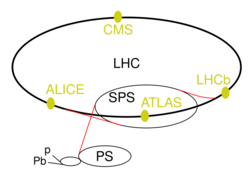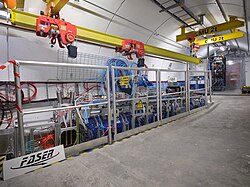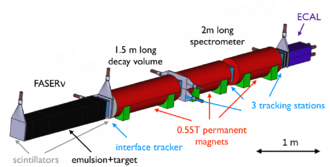Physics:FASER experiment
 | |
| LHC experiments | |
|---|---|
| ATLAS | A Toroidal LHC Apparatus |
| CMS | Compact Muon Solenoid |
| LHCb | LHC-beauty |
| ALICE | A Large Ion Collider Experiment |
| TOTEM | Total Cross Section, Elastic Scattering and Diffraction Dissociation |
| LHCf | LHC-forward |
| MoEDAL | Monopole and Exotics Detector At the LHC |
| FASER | ForwArd Search ExpeRiment |
| LHC preaccelerators | |
| p and Pb | Linear accelerators for protons (Linac 2) and Lead (Linac 3) |
| (not marked) | Proton Synchrotron Booster |
| PS | Proton Synchrotron |
| SPS | Super Proton Synchrotron |
FASER (ForwArd Search ExpeRiment) is one of the nine particle physics experiments in 2022 at the Large Hadron Collider at CERN. It is designed to both search for new light and weakly coupled elementary particles, and to detect and study the interactions of high-energy collider neutrinos.[1] In 2023, FASER and SND@LHC reported the first observation of collider neutrinos.[2]
The experiment is installed in the service tunnel TI12, which is 480 m downstream from the interaction point used by the ATLAS experiment.[3] This tunnel was formerly used to inject the beam from the SPS into the LEP accelerator. In this location, the FASER experiment is placed into an intense and highly collimated beam of both neutrinos as well as possible new particles. Additionally, it is shielded from ATLAS by about 100 meters of rock and concrete, providing a low background environment. The FASER experiment was approved in 2019.[4][5] The detector was built in the following two years and installed in 2021.[6] The experiment started taking data at the beginning of Run 3 of the LHC in summer 2022.[7][8][9]
New physics searches
The primary goal of the FASER experiment is to search for new light and weakly interacting particles, that have not been discovered yet, such as dark photons, axion-like particles and sterile neutrinos.[10][11] If these particles are sufficiently light, they can be produced in rare decays of hadrons. Such particles will therefore be dominantly produced in the forward direction along the collision axis, forming a highly collimated beam, and can inherit a large fraction of the LHC proton beam energy. Additionally, due to their small couplings to the standard model particles and large boosts, these particles are long-lived and can easily travel hundreds of meters without interacting before they decay to standard model particles. These decays lead to a spectacular signal, the appearance of highly energetic particles, which FASER aims to detect.
In March 2023, the FASER Collaboration reported their first results on the search for dark photons. No signal consistent with a dark photon was seen in their 2022 data and limits on previously unconstrained parameter space were set.
Neutrino physics
The LHC is the highest energy particle collider built so far, and therefore also the source of the most energetic neutrinos created in a controlled laboratory environment. Indeed, collisions at the LHC lead to a large flux of high-energy neutrinos of all flavours, which are highly collimated around the beam collision axis and stream through the FASER location.
In 2021, the FASER Collaboration announced the first detection of collider neutrino candidates.[12][13][14][15][16] The data used for this discovery was collected by a small emulsion pilot detector with a target mass of 11 kg. The detector was placed in the service tunnel TI18, and the data was collected for only four weeks during LHC Run 2 in 2018. While this outcome falls short of being a discovery of collider neutrinos, it highlights the potential and feasibility of conducting dedicated neutrino experiments at the LHC.
In 2023, the FASER Collaboration announced[17][18][19] and published[2] the first observation of collider neutrinos. For this, they searched for events in which a high momentum track emerges from the central part of the FASERv detector volume and no activity in the most upstream veto layers, as expected from a muon neutrino interaction. This search was performed using only the electronic detector components.
To study these neutrino interactions in greater detail, FASER also contains the dedicated FASERv sub-detector (which is pronounced FASERnu).[20][21] During its nominal run time of a few years, about 10000 neutrinos are expected to be recorded by FASERν.[22] These neutrinos typically have TeV scale energies, allowing FASERv to study their interactions in a regime where they are currently unconstrained.
FASERnu will be capable of exploring the following physics domains:
- FASERv will measure neutrino-nucleus interaction cross sections for all three neutrino flavours at the TeV energy scale. With the ability to identify the neutrino flavor, it will allow to test lepton flavour universality in neutrino scattering.
- FASERv will be able to see the highest number of tau neutrino interactions, allowing to study this elusive particle in greater detail.
- FASERv will carry out very precise measurements of muon neutrino interactions at an energy scale never explored before. These measurements will allow to probe the proton's structure and constrain parton distribution functions.
- Neutrinos at FASERv are primarily produced in the decay of pions, kaons and charmed hadrons. The measurement of the neutrino fluxes therefore allows to constrain the production of these particles in kinematic regime that is inaccessible for the other LHC experiments. This will provide new key inputs for astro-particle physics experiments.
Detector
Located at the front end of FASER is the FASERν neutrino detector. It consists of many layers of emulsion films interleaved with tungsten plates as target material for neutrino interactions. Behind FASERν and at the entrance to the main detector is a charged particle veto consisting of plastic scintillators.[23][24] This is followed by a 1.5 meter long empty decay volume and a 2 meter long spectrometer, which are placed in a 0.55 T magnetic field. The spectrometer consists of three tracking stations, composed of layers of precision silicon strip detectors, to detect charged particles produced in the decay of long-lived particles. Located at the end is an electromagnetic calorimeter.
References
- ↑ "FASER detector at the Large Hadron Collider to seek clues about hidden matter in the universe". 2019-03-05. https://www.washington.edu/news/2019/03/05/faser-detector-lhc/.
- ↑ Jump up to: 2.0 2.1 Worcester, Elizabeth (July 19, 2023). "The Dawn of Collider Neutrino Physics". Physics 16: 113. https://physics.aps.org/articles/v16/113. Retrieved July 23, 2023.
- ↑ "LS2 Report: FASER is born" (in en). https://home.cern/news/news/experiments/ls2-report-faser-born.
- ↑ "FASER: CERN approves new experiment to look for long-lived, exotic particles" (in en). https://home.cern/news/news/experiments/faser-cern-approves-new-experiment-look-long-lived-exotic-particles.
- ↑ "FASER's new detector expected to catch first collider neutrino" (in en). https://home.cern/news/news/physics/fasers-new-detector-expected-catch-first-collider-neutrino.
- ↑ "FASER Detector Installation" (in en). https://ep-news.web.cern.ch/content/faser-detector-installation.
- ↑ Garisto, Daniel. "Large Hadron Collider Seeks New Particles after Major Upgrade" (in en). https://www.scientificamerican.com/article/large-hadron-collider-seeks-new-particles-after-major-upgrade/.
- ↑ Liverpool, University of. "Large Hadron Collider takes first data in record-breaking run" (in en). https://phys.org/news/2022-07-large-hadron-collider-record-breaking.html.
- ↑ "LHC Run 3: physics at record energy starts tomorrow" (in en). https://atlas.cern/Updates/Press-Statement/LHC-Run3-Starts.
- ↑ Feng, Jonathan L.; Galon, Iftah; Kling, Felix; Trojanowski, Sebastian (2018-02-05). "FASER: ForwArd Search ExpeRiment at the LHC". Physical Review D 97 (3): 035001. doi:10.1103/PhysRevD.97.035001. ISSN 2470-0010.
- ↑ Ariga et al. (FASER Collaboration) (2019-05-15). "FASER's Physics Reach for Long-Lived Particles". Physical Review D 99 (9): 095011. doi:10.1103/PhysRevD.99.095011. ISSN 2470-0010. Bibcode: 2019PhRvD..99i5011A.
- ↑ FASER Collaboration; Abreu, Henso; Afik, Yoav; Antel, Claire; Arakawa, Jason; Ariga, Akitaka; Ariga, Tomoko; Bernlochner, Florian et al. (2021-11-24). "First neutrino interaction candidates at the LHC". Physical Review D 104 (9): L091101. doi:10.1103/PhysRevD.104.L091101. https://link.aps.org/doi/10.1103/PhysRevD.104.L091101.
- ↑ "Neutrinos were caught interacting at the Large Hadron Collider | Science News" (in en-US). 2021-05-26. https://www.sciencenews.org/article/neutrinos-detection-large-hadron-collider.
- ↑ "UCI-led team of physicists detects signs of neutrinos at Large Hadron Collider" (in en-US). 2021-11-24. https://news.uci.edu/2021/11/24/uci-led-team-of-physicists-detects-signs-of-neutrinos-at-large-hadron-collider/.
- ↑ "Neutrinos detected in particle collider for first time at CERN" (in en-US). https://www.jpost.com/science/neutrinos-detected-in-particle-collider-for-first-time-at-cern-687181.
- ↑ Dorminey, Bruce. "Suitcase-Sized Neutrino Detector Hits Pay Dirt At Large Hadron Collider" (in en). https://www.forbes.com/sites/brucedorminey/2021/11/24/suitcase-sized-neutrino-detector-hits-pay-dirt-at-large-hadron-collider/.
- ↑ "UC Irvine-led team is first to detect neutrinos made by a particle collider" (in en-US). 2023-03-20. https://news.uci.edu/2023/03/20/uc-irvine-led-team-is-first-to-detect-neutrinos-made-by-particle-collider/.
- ↑ "First detection of neutrinos made at a particle collider" (in en). https://www.sciencedaily.com/releases/2023/03/230320143806.htm.
- ↑ "DESY News: Res eaname rch team detects first neutrinos made by a particle collider" (in en). https://www.desy.de/news/news_search/index_eng.html?openDirectAnchor=2668.
- ↑ Abreu et al. (FASER collaboration) (2020). "Detecting and Studying High-Energy Collider Neutrinos with FASER at the LHC". The European Physical Journal C 80 (1): 61. doi:10.1140/epjc/s10052-020-7631-5. Bibcode: 2020EPJC...80...61A.
- ↑ Krishna, Chetna. "Catching neutrinos at the LHC" (in en). https://www.symmetrymagazine.org/article/catching-neutrinos-at-the-lhc.
- ↑ Kling, Felix; Nevay, Laurence J. (2021-12-29). "Forward neutrino fluxes at the LHC". Physical Review D 104 (11): 113008. doi:10.1103/PhysRevD.104.113008. https://link.aps.org/doi/10.1103/PhysRevD.104.113008.
- ↑ Ariga et al. (FASER Collaboration) (2018-11-26). "Letter of Intent for FASER: ForwArd Search ExpeRiment at the LHC". arXiv:1811.10243 [physics.ins-det].
- ↑ Ariga et al. (FASER Collaboration) (2018-12-21). "Technical Proposal for FASER: ForwArd Search ExpeRiment at the LHC". arXiv:1812.09139 [physics.ins-det].
External links
[ ⚑ ] 46°14′09″N 6°03′18″E / 46.23583°N 6.055°E
 |




